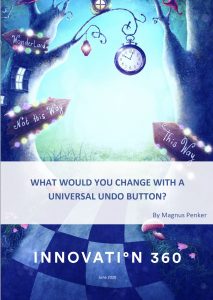The perpetual engine of science fiction
As you prepare yourself to innovate without fear, there may be no better place to start than inside classic works of science fiction.
All of science and all of fiction emerge from a single impetus and single word – If. The word if is the atomic unit of counterfactuals. From that launchpad you can build any experiment.
To innovate repeatedly and successfully, it will be necessary for your company to develop an If Launchpad. This is where innovations will be built and where they will blast off into the market.
Thought experiments that take off from the If Launchpad begin with the natural world and then slightly alter a few critical factors to see what that does to the world.
Literary works at the intersection of science and fiction has been a rich source of innovation since the genre began in Ancient Rome. The first science fiction story was an ironically named tale called A True Story, about a voyage to the moon. It was written by Lucian who wandered the ancient world as an itinerant rhetorician. In other words, he went about arguing with people for a living. Lucian’s work was listed as an inspiration by the chemical engineers and aeronautics designers who built the first rocket that actually went to the moon.
You have doubtless heard of other science fiction speculations that became real-world success stories. Some examples from the nineteenth century include television, genetic engineering, and lasers predicted by HG Wells or smartphones and nuclear submarines envisioned by Jules Verne. A work of speculative fiction verging on science fiction inspired the invention of the Internet, which began with Vannevar Bush’s As We May Think.
In my own experience, I took part in a large-scale research project that sought to bring to life a translation device, similar to the Babel Fish from The Hitchhiker’s Guide to the Galaxy by Douglas Adams. If you haven’t read the book, the Babel Fish is an alien creature that automatically translates any language in the universe. All you have to do is stick the wiggly fish into your ear.
This Babel Fish-inspired research project was known as Verbmobil. Its goal was to develop a robust algorithm inside a portable travel device that could translate speech instantaneously and bidirectionally from one language to another. For simplicity, we began with German to English and German to Japanese. It was funded by the German Federal Ministry of Research and Technology, using the resources of the German Research Center for Artificial Intelligence in Saarbrücken, in association with the Advanced Telecommunications Research Laboratories in Kyoto, Japan.
More than 900 researchers and engineers spent nearly a decade of intensive research on topics that included deep semantic analysis, where research concentrated on recognizing casual mistakes in everyday speech. By comparing what a speaker said against what they were trying to say, the AI began to understand patterns of thought and ellipses.
Flexible short hands in every spoken language simplify both communication and understanding for speakers and their listeners, but they tend to wreak havoc on rigid rules-based systems. The Verbmobil project established for the first time the theoretical and practical foundations of the signal processing that people perform autonomously every day.
Speech processing, prosodic analysis, parsing, semantic analysis, discourse understanding, translation, generation and speech synthesis were all codified and published for anyone to access. It has since become a landmark project in the history of natural language processing, often referred to as NLP.
Today, Verbmobil’s industrial partners, including DaimlerChrysler, Philips, Siemens, and Temic are applying the resources in translation developed during this project. This is one of the best examples of what we call the Third Innovation Horizon. The goal of these projects is not to return profits for one individual company, but to build a new S-Curve that your company can build products for in the Second Innovation Horizon and extract profits from in the First Innovation Horizon.
There were many wrong turns and false starts in understanding this complex series of problems. If they would have begun by listening to the experts in language translation, the project would have been mired from the start in faulty assumptions. They used the Universal Undo Button many times to rerun experiments, each with a new hypothesis.
Hypothesis testing is both the cornerstone of science and the most direct path to successful innovation.
The secret is in doing many, many experiments, but doing them as cheaply as possible. Otherwise, you will bankrupt the business in trying to save it. To illustrate how that works, let’s talk a bit about real life zombies.


